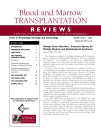Treatment Advances for Multiple Myeloma and Mantle Cell Lymphoma: The Changing Landscape
by John R. Wingard and Baldeep Wirk
The management of multiple myeloma has changed dramatically over the past 2 decades. Testing of new treatment options continues at a rapid pace. The advances have resulted in improved survival rates not only in clinical trial participants, but these benefits have been applied to general practice and survival rates are improving in population-based studies as well. Although cure largely remains beyond a realistic prospect, durable control of disease is achievable in the majority of patients. Multiple myeloma is characterized by clinical heterogeneity based largely on genetics; therefore, a risk adapted strategy may be helpful in guiding therapeutic decisions. More progress is needed and many questions remain about how to choose between the various current and emerging treatment options in clinical practice. Such issues are being addressed in current and planned future studies: what are the best first-line and salvage treatment options and what options should be considered for various subgroups of patients, including the elderly, those with renal dysfunction, and those with certain comorbid medical conditions, such as peripheral neuropathy. Toxicities remain a challenge and occur with regularity in many of the treatment regimens. As multiple myeloma emerges as more of a chronic disease, considerable attention is being given to how we can best minimize toxicities with these regimens and thereby improve the quality of life.
Progress has also occurred with mantle cell lymphoma but at a much slower pace. Improved understanding about the heterogeneity of clinical behavior is perhaps one of the most important insights, some cases assuming an indolent course, other cases taking a much more aggressive course. Several case series suggest intensive treatment regimens that include stem cell transplantation may be helpful. Novel regimens including rituximab, bortezomib, and bendamustine have offered new hope to patients with this challenging subtype of non-Hodgkin lymphoma. How to select the optimal therapy for individual patients eludes us at present, but studies continue with the hope of significantly impacting the natural history of mantle cell lymphoma.
This issue contains extracts of a satellite symposium held at the 2008 BMT Tandem Meetings in San Diego, CA. Dr. Robert Rifkin discusses data presented at the 2007 American Society of Hematology meeting describing new treatment options for both multiple myeloma and mantle cell lymphoma. Dr. David Vesole focuses on concerns about toxicities of various treatment options for multiple myeloma. Dr. Christopher Flowers addresses first-line and salvage treatment options for mantle cell lymphoma and the role of HCT.
The fact that the first treatment decision can truly influence the ultimate disease outcome gives great impetus to determining how best to position the exciting new treatment options for individual patients. Hopefully, the needed answers will be forthcoming in future studies.
Download a PDF version of the full issue.

